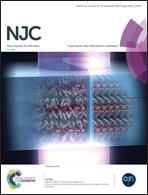Lithium titanate anode for high-performance lithium-ion batteries using octadecylamine and folic acid-functionalized graphene oxide for fabrication of ultrathin lithium titanate nanoflakes and modification of binder†
Abstract
This paper reports a strategy for the fabrication of lithium titanate anodes for high-performance lithium-ion batteries. First, octadecylamine and folic acid co-functionalized graphene oxide is dispersed in tertbutanol. Then, tetrabutyl titanate and lithium acetate are added. The mixed solution is heated at 180 °C to form a lithium titanate precursor, which is further treated by thermal annealing at 650 °C in Ar/H2. The resulting lithium titanate–graphene hybrid shows a three-dimensional structure. Ultrathin lithium titanate nanoflakes are embedded in graphene sheets. The unique structure exhibits large specific surface area and good conductivity. Furthermore, graphene oxide is introduced into PVDF for binder modification. The PVDF–graphene oxide composite film exhibits much higher elasticity modulus (>5 times), larger lithium-ion diffusion coefficient (>1.5 times) and lower electron transfer impedance (>2 times) compared with single PVDF film. The as-prepared lithium titanate–graphene anode provides high specific capacity (222.4 mA h g−1 at 0.2C), high rate capability (112.1 mA h g−1 at 10C) and excellent cycling stability (99.6% capacity retention at 1C after 1200 cycles) for lithium-ion batteries.



 Please wait while we load your content...
Please wait while we load your content...